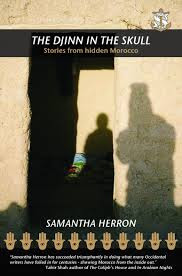Samantha Herron's debut short story collection 'The Djinn in the Skull: Stories from hidden Morocco' was published by Soul Bay Press late October. The collection of vignettes are tales inspired by her experiences living with an Amazigh (Berber) family
I studied classical Arabic and the Quran with the women of the village, travelled in the desert, learned how to take care of camels and sheep, how to wash and pray, and helped the other women in the family with the day-to-day running of the home. I fell in love with storytelling and stories, which are at the heart of everyday life in Morocco: sharing old stories handed down from generation to generation, embellishing jokes, spreading gossip or simply recounting a personal experience. I began to document the stories I was hearing and then found myself imagining and composing my own - Samantha HerronThis slim volume of stories contains local stories that Herron collected and some that she created herself. They are poignant tales of magic, love and loss. Their brevity makes them vignettes rather than short stories and yet they have a power that belies their short length. The stories are retold in modern times and so from time to time a character will produce a smart phone, or mention watching television. This intrusion of the contemporary into ancient tales is a device that works to enhance the notion that the reader is getting a remarkable insight into the longevity of traditional beliefs held by Moroccans living today in the Draa valley.
It is unfortunate that Herron does not tell the reader which stories are those of the villagers she lived with in the Draa valley and which are her own. Her claim to have "studied classical Arabic and the Quran with the women of the village" is strange as a majority of the people in that area speak either Amazigh or Darija, rather than classical Arabic. That aside, the book has been well received. Writers such as Tahir Shah, author of 'The Caliph's House' and 'In Arabian Nights', says that 'Samantha Herron has succeeded triumphantly in doing what many Occidental writers have failed in for centuries - showing Morocco from the inside out. The stories she has so eloquently told are part of the 'real' Morocco, a kingdom that is so often invisible to visitors.'
The author of 'Travels with a Tangerine: A Journey in the Footnotes of Ibn Battutah', Tim Mackintosh-Smith agrees: 'Samantha Herron found some of her Moroccan stories ready-made. Others she imagined or dreamed. In size they are miniatures; but they all express big things on a small scale. Reading them is like peering through a series of keyholes – and, each time, glimpsing something momentary but momentous, instants with life-long consequences. They will make you smile, and shiver. And they will tell you as much truth about their Moroccan setting as a shelf-full of ethnologies.'
Samantha Herron’s previous work includes the English and Arabic publication 'Dardasha: Testimonies of Migration by Moroccan Women' (Soul Bay Press 2011) which was produced in association with the Al Hasaniya Moroccan Women’s Centre in London
'The Djinn in the Skull: Stories from hidden Morocco' .
SHARE THIS!


4 comments:
You write "Her claim to have "studied classical Arabic and the Quran with the women of the village" is strange as a majority of the people in that area speak either Amazigh or Darija, rather than classical Arabic." Hmmmmmm, people in Fez do not speak (sic) classical Arabic either but many read and learn the classical Arabic of the Quran by rote from a very early age. Whether, she accomplished mastering the classical Arabic of the Quran is "as you say" is open to question. Regards Abd Rahman
Thank you for the review. I thought you might appreciate my clarifying a couple of points for you.
On the subject of what is 'real' and 'imagined' in the stories, I don't think that this should matter to the reader. Each story is what it is. When a Moroccan sits down and shares a story with a listener, he or she does not feel the need to point out what is fact or fiction. For indeed to even suggest that such a distinction exists is in itself misleading, as stories are always embellished over time and told from an individual's perspective.
Regarding my studying classical Arabic, I of course spoke Darija in the home and in daily life, but I did indeed study classical Arabic and the Quran in a local school with other woman from the village. It is part of the government's programme to educate women in rural areas, who have received little or no education, in mathematics, written Arabic and Quranic study.
Hope that clears a few things up for you
Thanks and best wishes
Samantha Herron
I enjoyed the stories but was also interested in which were the woman's and which the people's
Speaking Darija would have been needed and not everyone speaks the Saudi Arabic
Post a Comment